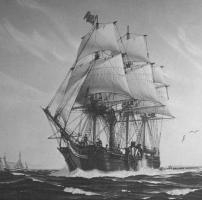 An updated repost on National Maritime Day. In 1933, the US Congress created National Maritime Day to recognize the maritime industry in the United States. The date chosen to celebrate the new holiday was May 22, in honor of the day that the auxiliary packet ship Savannah sailed from its namesake city in 1819. The Savannah is credited as the first steamship to cross the Atlantic Ocean.
An updated repost on National Maritime Day. In 1933, the US Congress created National Maritime Day to recognize the maritime industry in the United States. The date chosen to celebrate the new holiday was May 22, in honor of the day that the auxiliary packet ship Savannah sailed from its namesake city in 1819. The Savannah is credited as the first steamship to cross the Atlantic Ocean.
Bragging rights notwithstanding, if one is to be honest about the history, Savannah was neither a proper steamship nor did she actually cross the Atlantic primarily under steam.
She was built as a sailing packet ship for Captain Moses Rogers, and while she did have a 90 HP steam engine installed, which drove twin paddle wheels, she didn’t carry enough fuel to make the passage under steam power. On her first and only voyage under steam in 1819, the Savannah used her engine eastbound across the Atlantic for 80 hours in a voyage of 29 days and 11 hours. On the westbound voyage, which lasted 40 days, she did not use her engines at all.
Nevertheless, the novelty of a steam engine on an ocean-going ship attracted considerable attention. She was visited by US President James Monroe, as well as the Prince of Sweden and Norway. The King of Sweden and the Emperor of Russia each came aboard the ship, presenting gifts. While in Liverpool, thousands of people from all walks of life came to marvel at the new technology.
While she attracted attention, she did not attract passengers or cargo. Fire was a serious threat to wooden ships and many thought it crazy to book passage or freight on a ship that belched smoke from a fire in its boilers.
Ironically, it was a fire ashore, not on shipboard, that ended Savannah‘s career as a steamship. A fire in January 1820 swept through the business district of Savannah. The ship’s owners suffered major losses and were forced to sell the ship. Her engine was removed and sold separately and the ship sailed as a conventional packet ship until she ran aground along the south shore of Long Island in 1821 and was lost.
It would be another 18 years before the first ship would cross the Atlantic under steam. In 1838, Brunel’s SS Great Western steamship would become the first steamship to provide regular transatlantic service.
